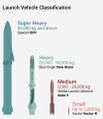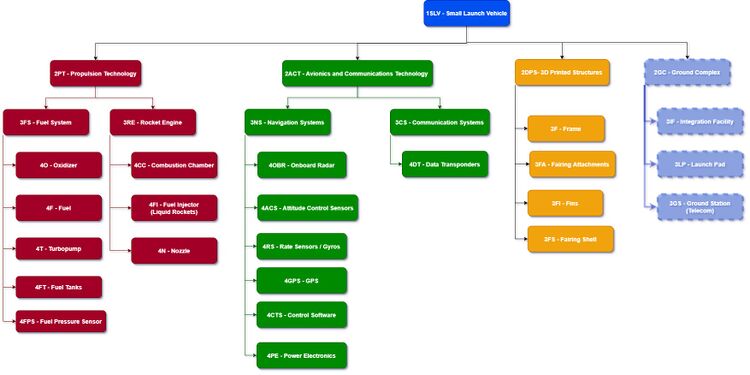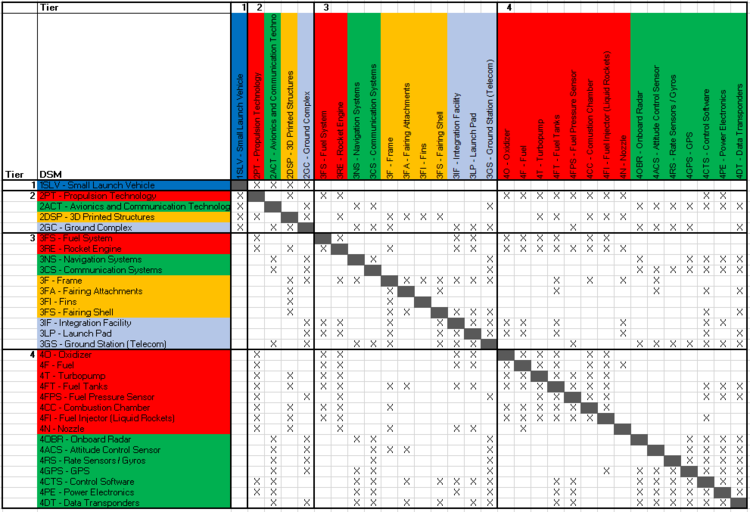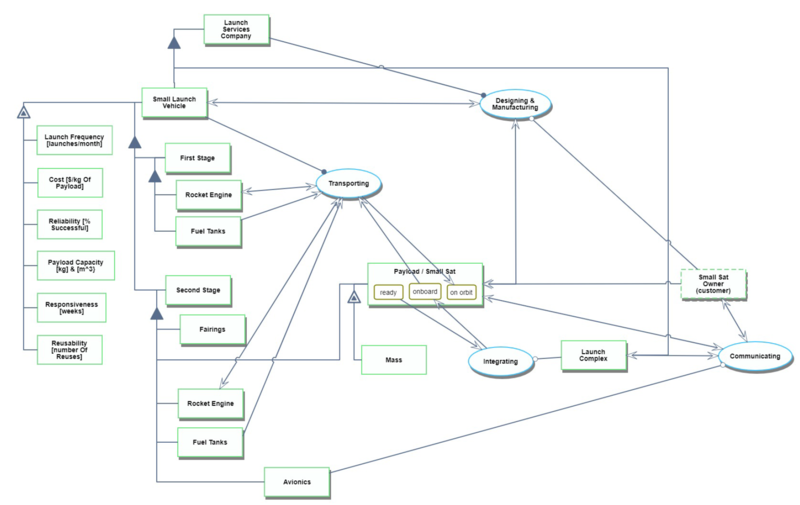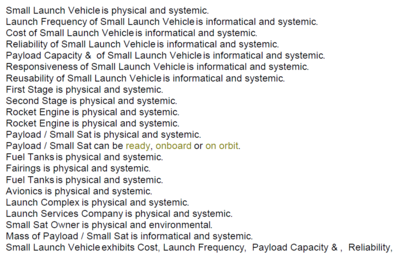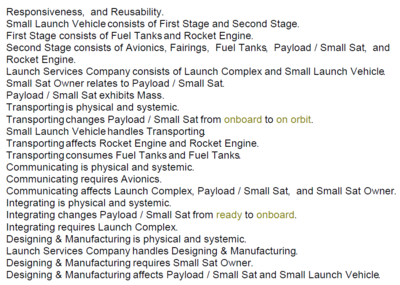Difference between revisions of "Hypersonic Transport Vehicles"
(Created page with "This page in progress") |
|||
| Line 1: | Line 1: | ||
This | =Technology Roadmap Sections and Deliverables= | ||
==Roadmap Overview== | |||
Small launch vehicles (SLVs, also called "Small launchers" or "Small-lift launch vehicles") are a category of orbital launchers capable of carrying a payload of maximum 2000kg* to LEO (Low Earth Orbit). Half a century ago, many families of launch vehicles have started as small launchers, as prototypes, and have led to today's large landscape of heavy launch vehicles (Ariane V, Falcon 9, Soyuz, Delta IV...). Today, the growing market of small satellites (below 500kg) - including, notably, LEO constellations projects and cubesats - pushes towards dedicated small launchers. This trend started in the 1990s and considerably accelerated in the 2010s with the development of a broad ecosystem of SLV startups. In comparison to conventional (heavy) launch vehicles, SLVs have: a higher scheduling flexibility, a higher launch frequency, a much lower total cost but a higher cost per kg of payload. | |||
<gallery class="center"> | |||
File:Categ.jpg|525px|center|Classification of SLVs among launch vehicles on their payload capacity. Source: SpaceCapital. | |||
Ng12timeline.jpg|450px|center|Launch profile of a typical SLV mission with 2 stages and non-reusable rocket (Antares here). Source: Northrop Grumman. | |||
File:Rocketlab2.jpg|415px|center|Launch of the Electron SLV (Rocket Lab). Source: Rocket Lab. | |||
File: Electron illustration.png|270px|center|System decomposition of a SLV (Electron here). Source: Rocket Lab. | |||
</gallery> | |||
'''*''': Diverse definitions exist. Some define small launchers as limited to 1 ton instead of 2 tons, some also define a lower boundary of 500kg under which launchers are called 'micro-launchers'. | |||
==Design Structure Matrix (DSM) Allocation== | |||
[[File:Hierarchy.jpg|750px|center]] | |||
The technology hierarchy demonstrates that such technologies as metal 3-D printing and modulable launchpads are supporting the development of small launchers. Initiatives and development plans for these technologies enhance small launchers by increasing their reusability, launch rate, scheduling flexibility, and reducing their cost per kilogram to launch payloads into orbit. | |||
[[File:DSM_v2.PNG|750px|center]] | |||
==Roadmap Model using OPM== | |||
We provide below an Object-Process-Diagram (OPD) of the 1SLV roadmap. This diagram captures the main object of the roadmap, its decomposition into subsystems (engines, avionics, payload...), its characterization by Figures of Merit (FOMs) as well as the main processes and actors involved. | |||
[[File:Opm.PNG|800px|center]] | |||
An Object-Process-Language (OPL) description of the technology is auto-generated and given below: | |||
[[File:Opl1.PNG|400px|center]][[File:Opl2.PNG|400px|center]] | |||
==Figures of Merit== | |||
Figures of Merit (FoM) used to evaluate small launchers are very similar to the FoMs used for conventional launch vehicles. However, priorities among these FoMs have changed significantly. Typical FoMs for small launchers are: | |||
{| class="wikitable sortable" style="margin-left: auto; margin-right: auto; border: none;" | |||
|- | |||
! Figure of Merit (FOM) !! Unit !! Description | |||
|- | |||
| Scheduling flexibility || [weeks or months or years] || How quickly the launch vehicle can go from initial talks with customer to launch to LEO. (Sometimes called Responsiveness, it is the duration between the launch window and the notification of its flight parameters - orbit, latitude, date, etc.) | |||
|- | |||
| Launch Frequency || [launches/month] || The number of launches a launch vehicle can perform in a month | |||
|- | |||
| Cost per kg || [$/kg of payload to LEO] || The total cost of the launch divided by the amount of payload to 500km LEO | |||
|- | |||
| Reliability || [% of successful launches] || The percentage of launches out of total launches that are successful as determined by ability to meet end requirements of customers | |||
|- | |||
| Payload mass capacity || [kg of payload to 500km LEO] || The amount of payload in kilograms that can be launched to 500km Low Earth Orbit (LEO) with the launch vehicle. LEO is a large range and so this FOM standardizes the various launch vehicles by specifying 500km LEO | |||
|-w | |||
| Total cost || [$] || The total cost of the launch, which is complementary to the cost per kg as it indicates the price of a ticket for a customer to get a dedicated launch (with dedicated orbit parameters, etc.). | |||
|- | |||
| Reusability || [Number of reuse cycles] || The number of times a launch vehicle can be reused before a new one must be built | |||
|- | |||
|} | |||
Revision as of 13:35, 8 October 2023
Technology Roadmap Sections and Deliverables
Roadmap Overview
Small launch vehicles (SLVs, also called "Small launchers" or "Small-lift launch vehicles") are a category of orbital launchers capable of carrying a payload of maximum 2000kg* to LEO (Low Earth Orbit). Half a century ago, many families of launch vehicles have started as small launchers, as prototypes, and have led to today's large landscape of heavy launch vehicles (Ariane V, Falcon 9, Soyuz, Delta IV...). Today, the growing market of small satellites (below 500kg) - including, notably, LEO constellations projects and cubesats - pushes towards dedicated small launchers. This trend started in the 1990s and considerably accelerated in the 2010s with the development of a broad ecosystem of SLV startups. In comparison to conventional (heavy) launch vehicles, SLVs have: a higher scheduling flexibility, a higher launch frequency, a much lower total cost but a higher cost per kg of payload.
*: Diverse definitions exist. Some define small launchers as limited to 1 ton instead of 2 tons, some also define a lower boundary of 500kg under which launchers are called 'micro-launchers'.
Design Structure Matrix (DSM) Allocation
The technology hierarchy demonstrates that such technologies as metal 3-D printing and modulable launchpads are supporting the development of small launchers. Initiatives and development plans for these technologies enhance small launchers by increasing their reusability, launch rate, scheduling flexibility, and reducing their cost per kilogram to launch payloads into orbit.
Roadmap Model using OPM
We provide below an Object-Process-Diagram (OPD) of the 1SLV roadmap. This diagram captures the main object of the roadmap, its decomposition into subsystems (engines, avionics, payload...), its characterization by Figures of Merit (FOMs) as well as the main processes and actors involved.
An Object-Process-Language (OPL) description of the technology is auto-generated and given below:
Figures of Merit
Figures of Merit (FoM) used to evaluate small launchers are very similar to the FoMs used for conventional launch vehicles. However, priorities among these FoMs have changed significantly. Typical FoMs for small launchers are:
| Figure of Merit (FOM) | Unit | Description |
|---|---|---|
| Scheduling flexibility | [weeks or months or years] | How quickly the launch vehicle can go from initial talks with customer to launch to LEO. (Sometimes called Responsiveness, it is the duration between the launch window and the notification of its flight parameters - orbit, latitude, date, etc.) |
| Launch Frequency | [launches/month] | The number of launches a launch vehicle can perform in a month |
| Cost per kg | [$/kg of payload to LEO] | The total cost of the launch divided by the amount of payload to 500km LEO |
| Reliability | [% of successful launches] | The percentage of launches out of total launches that are successful as determined by ability to meet end requirements of customers |
| Payload mass capacity | [kg of payload to 500km LEO] | The amount of payload in kilograms that can be launched to 500km Low Earth Orbit (LEO) with the launch vehicle. LEO is a large range and so this FOM standardizes the various launch vehicles by specifying 500km LEO |
| Total cost | [$] | The total cost of the launch, which is complementary to the cost per kg as it indicates the price of a ticket for a customer to get a dedicated launch (with dedicated orbit parameters, etc.). |
| Reusability | [Number of reuse cycles] | The number of times a launch vehicle can be reused before a new one must be built |
